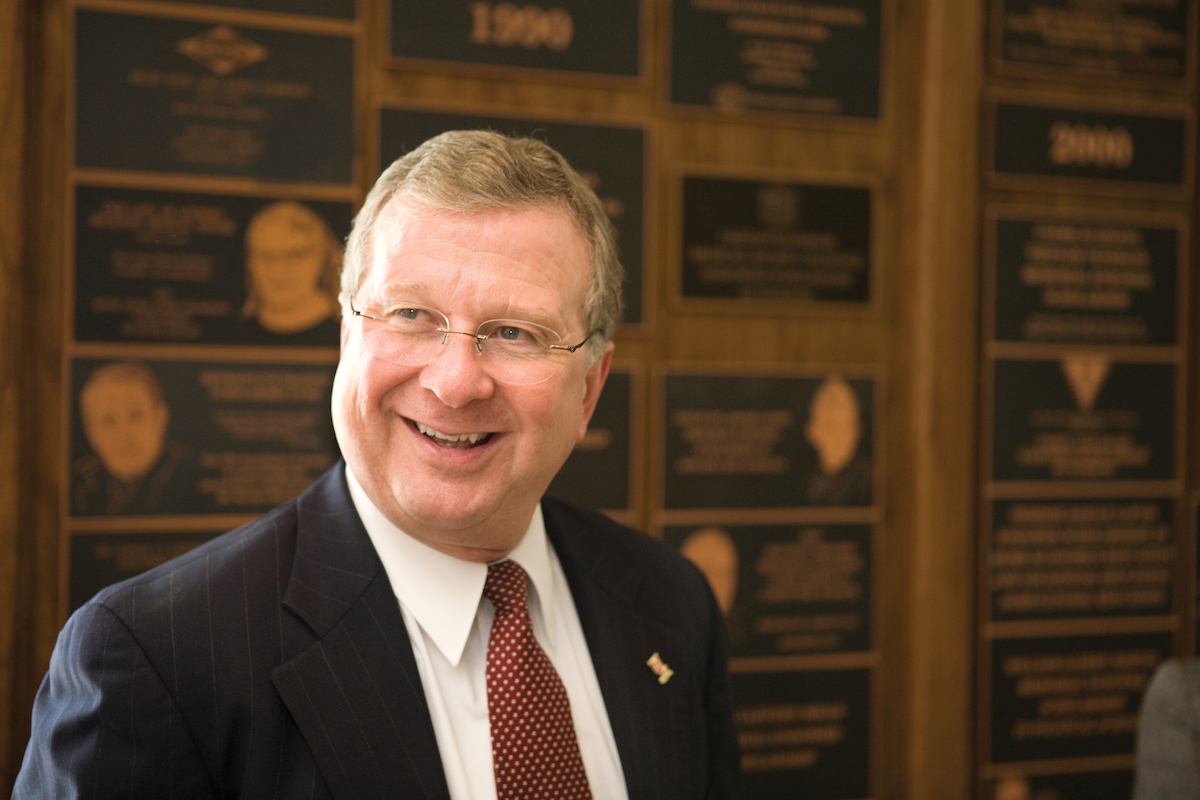Editor's Note: This article originally appeared in the Fall 2008 issue of La Louisiane. We've republished it from our archives in honor of President Savoie's 17-year tenure.
For Gail Savoie, the inauguration of her husband this fall as president of the University of Louisiana at Lafayette must have seemed a bit surreal. It was a reminder that, sometimes, it’s impossible to predict the future. She was 16 when she met and began dating Joseph “T-Joe” Savoie. He was 17. They attended the same high school in Sulphur, La. She was a cheerleader. He was a rascal, by all accounts. Gail Savoie remembers vividly the night of their first date. They had planned to go out after a home football game. She was on the sidelines, cheering for her team. “I look up in the stands and see the principal, Mr. Moses, in a suit, running down the bleachers, running after T-Joe, trying to catch him.”
Whatever offense Savoie was suspected of committing that night has probably been forgotten. But former elementary and high school classmates fondly recall that he was a charismatic leader at an early age. “He was funny. Kind of wild. And I liked him immediately,” said Maria Hart, a high school classmate.
Peggy Ducote, another high school classmate, remembers his devil-may-care attitude. “T-Joe was just out there, you know? Whenever he would come up with an idea that was so creative, he could get anybody to follow him. The leadership qualities were there.”
In an interview in October, Gail Savoie said that when Savoie graduated from high school, she thought he might become a lawyer.
“I’m still in a state of shock because I never dreamed, when I watched him go off to college, that he would end up being president of a university. Believe me, that was the last thing on his mind. I can tell you that right now,” she said, with a laugh.
Joseph Savoie was born in Sulphur, La., a blue-collar town about 10 miles west of Lake Charles, La.
As a child, he was given his nickname, “T-Joe,” by his French-speaking grandmother, who was known as “T-Ma.” “It just kind of followed him all the way through school and that’s the only way I know him,” Gail Savoie said.
He was the fifth of seven children. His mother was a teacher and his father was a businessman.
In an interview with La Louisiane, Savoie spoke about his parents’ influence on his life.
“I was taught, and began to believe at an early age, that each of us has a responsibility to the greater good and that we ought to use whatever talents that we have to contribute to the greater good in some fashion,” he said. “My parents, each in their own way, were role models for that philosophy.”
As a teenager, Savoie played bass guitar in a rock band, Five Stories High. Some of the other band members played football. Savoie stopped playing his sophomore year. “He didn’t want to get hurt,” Gail Savoie deadpanned, until she could no longer repress a chuckle.
At Sulphur High, Savoie was editor-in-chief of the school newspaper, a member of the debate team and was Charlie Brown in a school play. He also had a lot of fun.
It was apparent even then, Gail Savoie said, that he had a gift. “He was a born leader. He doesn’t like to draw attention to himself, but he’s the type of person that people are attracted to.”
After graduating from high school, Savoie entered the University of Southwestern Louisiana. As a freshman, he joined Kappa Sigma Fraternity. Chip Purpera, is one of Savoie’s close friends and a Kappa Sigma brother.
Like most fraternities, Purpera said, Kappa Sigma was created “for people to take care of each other and help each other. They were intended to help students be better students, to do benevolent things on campus. . . T-Joe took all of that seriously. And that’s the part that he wants to see keep going. He believes in the real reason why those organizations got started.”

Savoie, who served on the Union Program Council and the Student Government Association, was a dormitory counselor when Kappa Sigma got kicked off campus for an infraction. A handful of fraternity members weren’t present during the incident that prompted disciplinary action. One of them was Savoie; he soon became president and worked to keep the fraternity together. He was president of Kappa Sigma for nearly three years. In his senior year, he became president of the Interfraternity Council.
Gail and Joseph Savoie married in 1977, and he went to work for Schilling Distributors. About a year later, Raymond Blanco hired him as assistant dean of student personnel. Savoie began taking classes at night, working toward earning a master’s degree in educational administration.
In 1980, Savoie also became program director for Union Program Council and student government advisor.
The Savoie’s daughter, Blaire, was born in 1981.
In 1981, Savoie earned his master’s degree and became executive director of the USL Alumni Association and director of Alumni Affairs. The association had about 350 members and limited visibility. By the time he became director of University Advancement about 10 years later, there were about 8,000 members.
Kathleen Blanco, who is a University graduate, describes the transformation:
“When T-Joe became the alumni director, you saw the Alumni Association take a huge leap, a different direction. We became like alumni of other campuses. In fact, more like some alumni of private campuses,” she said. Blanco noted that at the time Savoie became the association’s director, public universities did not routinely ask for contributions from their graduates.
But, under Savoie’s direction, she continued, “alumni were reorganized and not just invited to party with us, because we can all do that extremely well, but also to make targeted contributions, to raise money, to go out and ask people to be an invested member of the university com-munity, to put some money back into the school that gave you the tools to get where you are. And that has paid big dividends.”
Dr. Camille Claibourne graduated from USL in 1978. She said it took a leader to convince alumni to take time from their busy schedules to “contribute back to the university. T-Joe did that for me.” She went on to serve as Alumni Association president from 1996 to 1997.
In the early 1980s, USL President Dr. Ray P. Authement assigned Savoie and Jimmy Clarke, dean of Student Personnel at the university, to handle legislative relations in Baton Rouge. Their first assignment: lobby to change USL’s name to a name that better reflected its national, rather than regional influence.
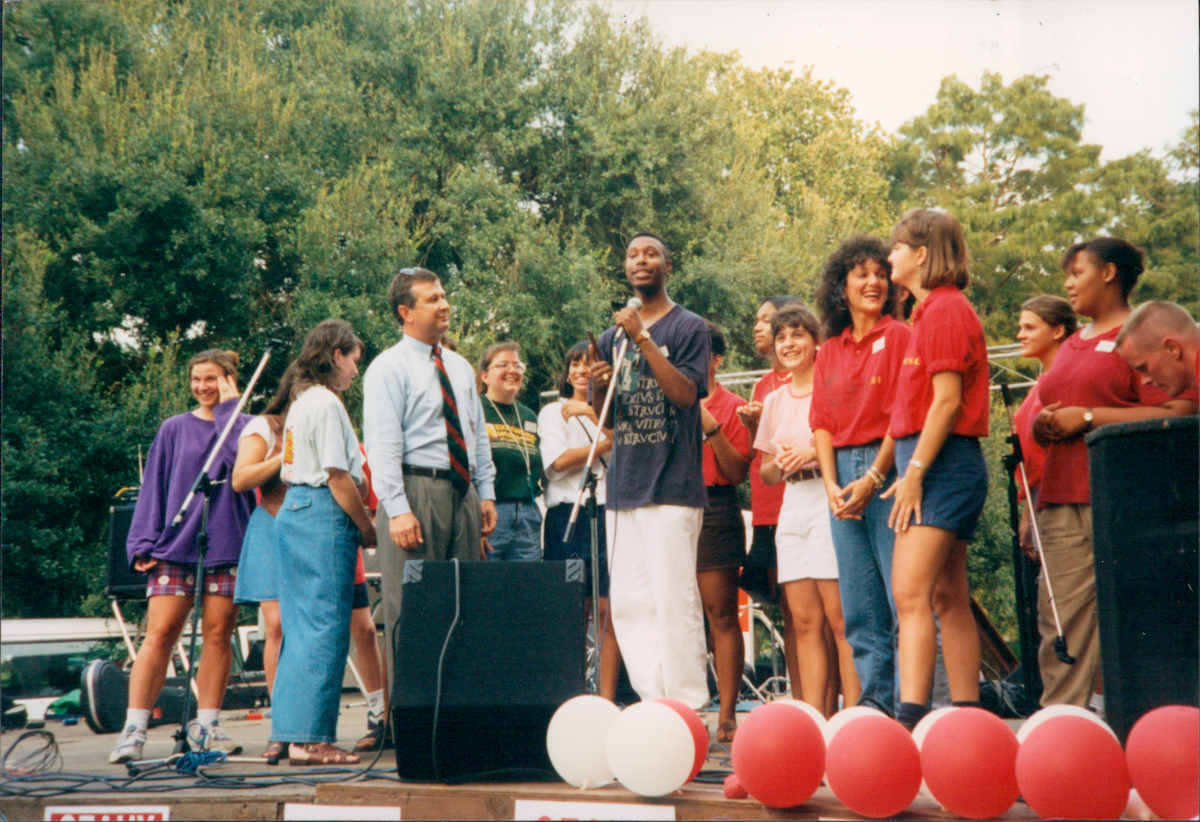
Savoie and Clarke rented a room where they could make their pitch, set up an overhead projector for a presentation and invited legislators. “We were proud of ourselves. But it was all for naught. We learned very quickly that there was a whole lot more to politics than overhead projectors and what we thought were the facts of the matter,” Clarke said.
Savoie became an ardent student of the political process. “I mean, when the legislature was in session, he was there,” Clarke noted.
With the help of several legislators, Savoie began to learn his way around the state capitol. He gradually made a name for himself as someone who did his homework, was fair and could be trusted. The education he received in the House and Senate would serve him well in years to come. He also continued to take classes at the university in the evenings.
In 1992, Authement appointed Savoie as vice president for University Advancement.
Adam Savoie was born in 1993. Four months later, Savoie began to pursue a doctorate from Columbia University’s Teacher’s College in New York City. Gail Savoie is candid about the sacrifice that was required for him to earn a doctoral degree.
“It was tough. He would leave in the summers and live in New York. I was on my own with a 4-month-old and a 10-year-old. But it was much harder on him than it was on me, because he hated leaving his family.
“He would come home in the fall and then every six weeks he would fly out on a Thursday to New York and stay until a Sunday night or Monday morning and come back. He never stopped working at UL while pursuing his doctorate,” she said. That last year, after the kids were put to bed, he studied every night from 10 p.m. to 2 a.m.
Savoie’s dissertation topic focused on the development of a service-learning program at USL. Over the next decade, Savoie also became involved with national higher education organizations. He served on the boards of the Southern Regional Education Board, the Council for the Advancement and Support of Education and as chairman of the board of the national association of State Higher Education Executive Officers. In 2005, he was chosen by the National Governors Association as one of six national experts to help governors from across the country develop progressive educational policies. That networking and exposure, like his legislative experience, would prove to be invaluable.
Savoie received a doctorate in educational leadership and administration from Columbia University’s Teacher’s College in the spring of 1995.
In 1995, M. J. “Mike” Foster, a Franklin, La., businessman, was elected governor of Louisiana. He fully grasped the importance of higher education to the state’s economy.
Foster appointed Savoie first to his higher education transition team and in 1996 encouraged the Louisiana Board of Regents to hire him as interim commissioner of higher education.
Savoie took a leave of absence from USL, assuming he would spend just a few months in Baton Rouge, La., as interim commissioner.
The Board of Regents soon offered the state’s highest education position to Savoie on a permanent basis.
“When I hired Joe, I was looking for somebody that could do the job of taking the (Board of) Regents and giving them back their constitutional mission, which was to coordinate all the colleges in the state,” Foster said in an interview in October. Kathleen Blanco was lieutenant governor then. She had served as a state representative and a member of the Public Service Commission.
Blanco describes what the higher education environment was like in the early to mid-1990s:
"The colleges that got the money were the colleges that had legislators in high and important positions. It was fast and furious. There was nothing systematic. There was nothing but strong-arm politics that decided funding, campus by campus. There was base funding, but there was all kind of jockeying for extra money for this, that, and the other, with no real sense of priority, just power politics.”
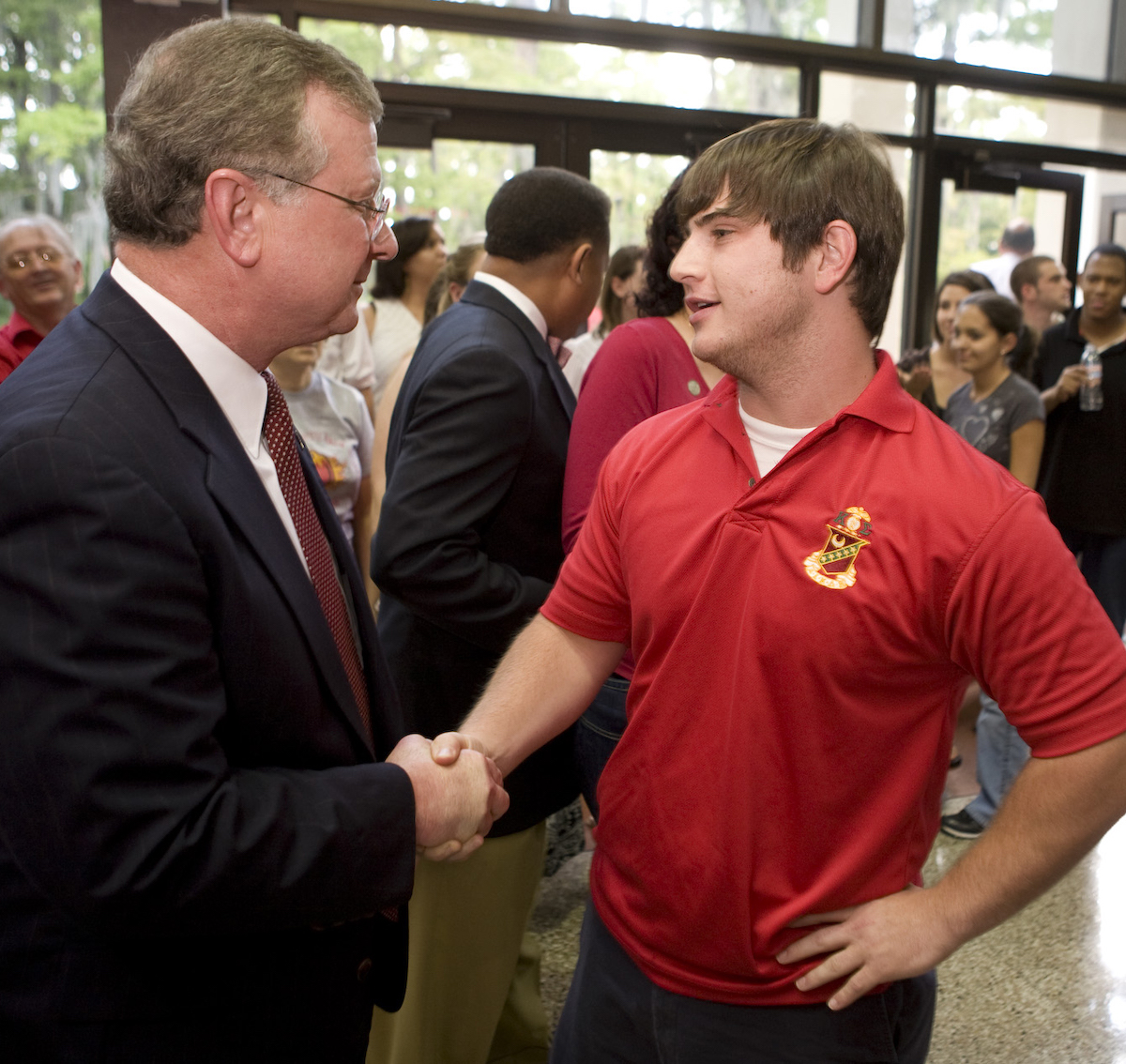
Savoie knew that environment well because of his experience as the university’s lobbyist.
In an interview in October, Dr. William Jenkins, former president of the LSU system, commented on Savoie’s political prowess. “T-Joe understood the machinery of state government and how the state capitol operated, and, at the same time, he understood the nuances. He understood the political overtones, and political relationships. He is a master of that, a master. Dr. Leon Tarver II, former president of the Southern University System, recalled Savoie’s early days as commissioner: “He was a listener… He talked to a lot of people and he listened to a lot of people. I think that in the process he began to crystallize an idea of where higher education should be going. . .”
Savoie earned points for keeping an open mind, Tarver said. “He had no predilection about what the answer ought to be. He always felt that the answer was somewhere in the discussion, in the debate. And his job was to find it.”
One of Savoie’s first tasks was to eliminate dozens of unnecessarily duplicated academic programs.
The Board of Regents had been working on that project for more than a year. “It was in total chaos because every school was jockeying to maintain their programs, to cut somebody else’s programs. I got on the road and started visiting campuses,” Savoie said in a recent interview.
“I met with campus administrators and told them, ‘I have to eliminate X number of programs. This is what’s on your list. What do you absolutely have to have and what can you give up? In-stead of dictating a result, I tried to work with the campuses on their individual needs and circumstances. It worked. We eliminated 100 duplicate programs – more than the number targeted.”
His administrative style, which is to include as many viewpoints as feasible, is one reason for his success. But Savoie is quick to point out that having Foster’s trust was also key in the early days of his career as commissioner. The governor let others know that Savoie was in charge. Savoie worked with two more governors after Foster and stayed in charge.
At one point in his early days as commissioner of higher education, Savoie and his wife had to make an important decision. Would they move from Lafayette to Baton Rouge? Rather than uproot his family from their home, Savoie chose to commute to Baton Rouge every day.
Gail Savoie said that having her husband on the road so much was stressful. “Between his mother and me, there were lots of prayers. . .
“There were many times when we were very worried because he was driving across the basin in bad weather. But he wanted to be home in the morning to see his son wake up and he wanted to be there in the evening to kiss him goodnight. He wanted us to stay in our community because we love Lafayette so much. That’s the kind of person he is. He is very, very giving.”
Soon after he became commissioner of higher education, Savoie received a letter from Zawonnica Mitchell, a student at a middle school in Shreveport. Her class was studying government. Zawonnica’s teacher had assigned her to write a letter to Savoie to invite him to visit their school.
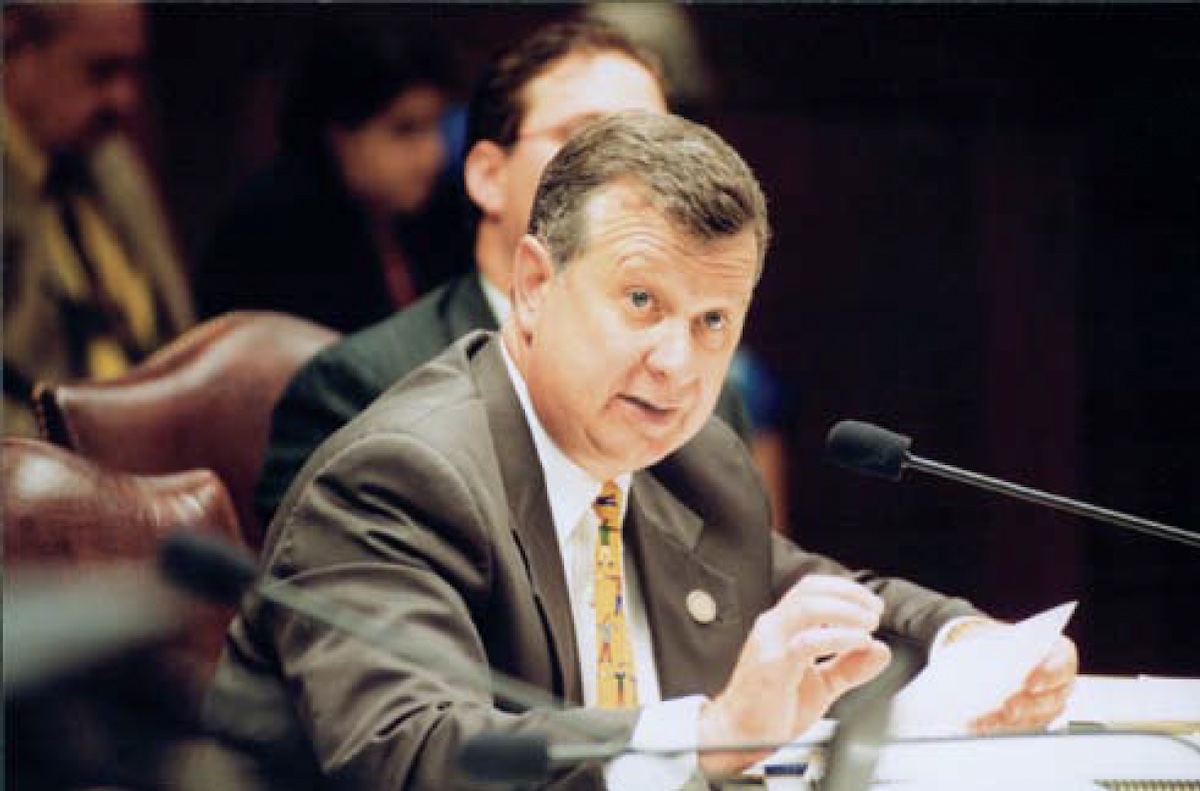
Savoie accepted the invitation and instead of a quick visit, spent most of the day there.
Gail Savoie said Zawonnica was extremely shy. “When T-Joe first met her, she spoke softly and would keep her head down. She wouldn’t make eye contact.”
Zawonnica was a good student and Savoie promised her that if she kept her grades up through high school, he would make sure she could go to college. He stayed in touch with her, attending school performances, encouraging her and sending her books to read that he thought she would enjoy.
Zawonnica graduated from high school and received a scholarship to Southern University. She recently earned a degree in political science and is now working toward teacher certification.
“She still calls him to discuss career options and they have a real good relationship,” Gail Savoie said. “I think he made a difference in this little girl’s life.”
Former Gov. Kathleen Blanco said in a recent interview that Savoie became “the commissioner who has had the most positive influence on all of education in Louisiana.”
Blanco explained that he convinced legislators that everything related to higher education should be handled through the Board of Regents. And, “Dr. Savoie sat down the leaders of the university campuses and convinced them that cooperative activity, going to the legislature with one message, a message for higher education, would be far, far better than the backbiting going on.”
But that was just the start of dramatic education reform.
“The miraculous thing that he was able to accomplish was to create a model, a unique model in the United States at that time, that education is one continuum from pre-K through higher education,” Blanco said. “Dr. Savoie worked with Superintendent of Education Cecil Picard, day in and day out, to make sure that each part of the educational process worked together and was relevant for the individual student and that nothing would be lost in between.”
As a result of this partnership, high school graduation rates improved, college attendance grew, ACT scores increased, teacher education programs at colleges across the state were redesigned and the number of certified teachers being produced by the state’s colleges increased significantly.
In addition, under Savoie’s leadership as commissioner:
- higher education governance was restructured;
- a statewide community and technical college system was created;
- a master plan for public postsecondary education, which included admissions criteria for universities, was implemented;
- the state’s first need-based financial aid program was established;
- college graduation rates improved;
- federal research grants doubled;
- national accreditation of academic programs statewide reached nearly 100 percent;
- monetary support for public colleges and universities nearly tripled; and
- education became a key component of Louisiana’s efforts to improve its economy and its residents’ quality of life.
Savoie guided universities as they strengthened their admissions criteria and helped establish new community colleges.
Blanco noted that many of the changes were controversial and politically challenging, but they were made “with the least amount of noise and antagonism that one could ever imagine.”
On Aug. 29, 2005, Hurricane Katrina hit south Louisiana. At first, it seemed as if damage was minimal. Then levees around New Orleans began to fail, allowing surrounding water to inundate much of the Crescent City.
Savoie responded immediately by calling the state’s higher education leadership together and setting priorities.
“The first thing we focused on were people issues,” he said in a recent interview. “We contacted campus presidents to check on their safety and get their assessments of impacted students, faculty and staff. It was soon apparent that over a dozen college and university campuses in the New Orleans area were shut down and probably wouldn’t be able to open any time soon.
More than 80,000 college students were displaced. Within 24 hours, websites were created to help students and faculty.
“We put in place a policy that students could move to any other campus that was operational – without any bureaucracy, without the necessity of records and files because those were under water, and without any additional costs. If they had paid tuition at their home institutions, then they would not have to pay anything else. We set up a locator and placement system for displaced faculty so they could work at functioning campuses and help teach dis-placed students,” he continued.
“We guaranteed faculty that they weren’t going to lose their jobs immediately, that we would find some placement for them and we then issued a public statement which guaranteed employment at least through the end of the calendar year for all affected employees. I took some legislative heat for that, but the worst thing that could have happened to people who lost their homes was to have their jobs taken away from them as well.
“It was over a week before we were able to physically get to any of the campus- es and they were still under water. Just as we were getting a good handle on things, Hurricane Rita came and re-flooded every-thing in New Orleans and took out McNeese State University and Sowela Technical Community College in Lake Charles.”
Savoie worked with the Congressional delegation and managed to obtain an initial emergency allocation of $85 million from the federal government to stabilize many of the campuses. That allowed universities to pay salaries, for example. The funds also allowed the state to make a $1,000 “Return to Learn” scholarship available for each college student who had been displaced.
One of the state’s challenges was keeping its finances stable in the immediate aftermath of the hurricanes and flooding. State agencies were asked to cut their budgets. Higher education had about a week to carve out $75 million.
“We tried to do that strategically so that we would do the least damage to campuses that were not directly affected and who had absorbed 20,000 new students,” Savoie said.
He summarized the Board of Regents’ role after Hurricanes Katrina and Rita struck: “We just took control and started doing things, always focused on people first, infrastructure second, working around rules and regulations third, and politics not at all. Once people saw that’s what we were doing, they were willing to stay out of the way and let us take care of our business.”
In 2006, Savoie continued to work on hurricane recovery and rebuilding Louisiana’s higher education system. When the state’s economy began to re-bound with a post-hurricane spending frenzy, he was able to secure from the legislature not only the $75 million that had been cut from the budget the previous year, but an additional $160 million.
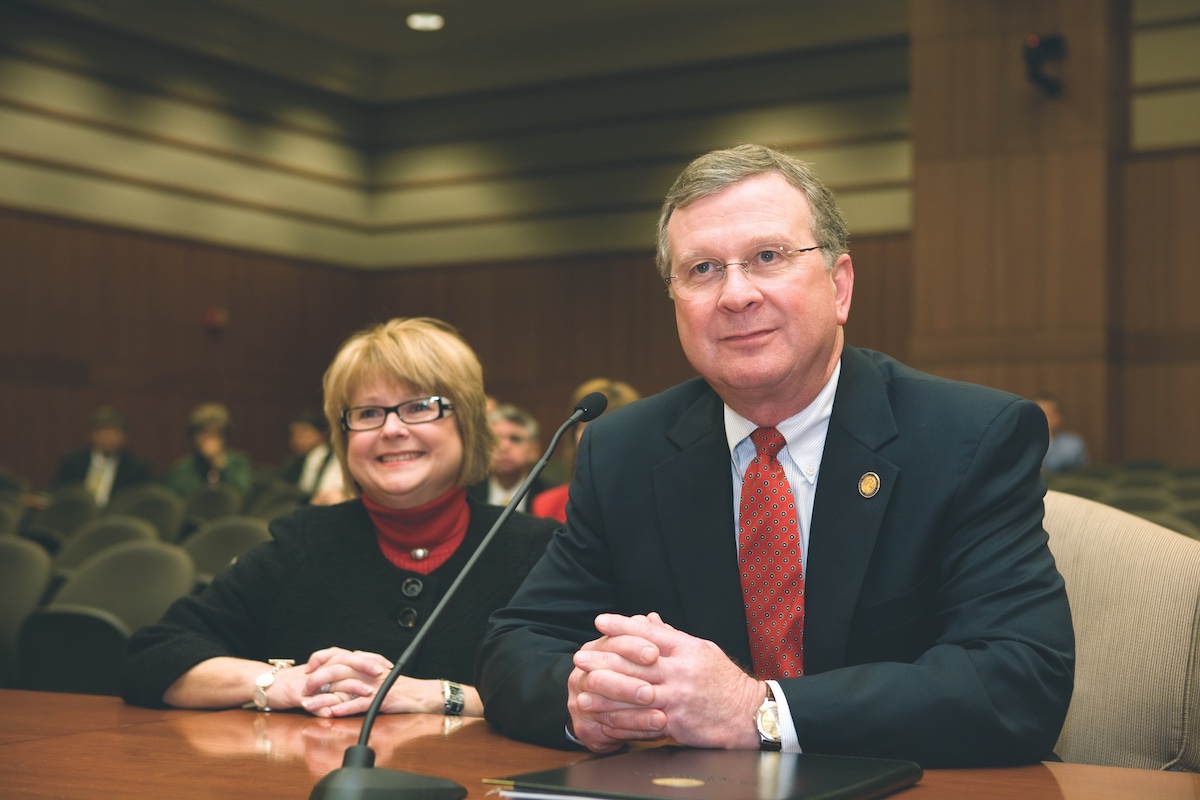
In 2007, Dr. Ray P. Authement announced he would retire, after serving as UL Lafayette’s president for 34 years. The University of Louisiana System made the selection process for his replacement as transparent as possible. So, every applicant’s name and background information were made public.
Savoie was one of the last to apply.
Dr. Steve Landry, vice president for Academic Affairs at UL Lafayette, was one of the contenders. He is well respected and popular with faculty and staff. In public interviews conducted by the board, he was articulate and enthusiastic.
Savoie, on the other hand, seemed ambivalent about seeking the position.
Did he not want the university president’s duties? Or, was he reluctant to leave his position as commissioner because he thought there was more he could accomplish?
In an interview after his inauguration, Savoie answered those questions candidly.
“I very much enjoyed the work that I did at the Board of Regents. I felt like the state had made some significant progress and I felt good about my role in that progress. One of the issues that I struggled with was, where could I contribute the most?
“Ultimately, it came down to some ego deflating. (I realized) that if I had done my job properly, then the board and the staff and my successor would be able to continue the momentum and build on it even further. Progress wasn’t dependent on me personally. But I would have been happy to stay in the commissioner’s role for the rest of my career. Now that I am here, I feel the same way about being at UL.”
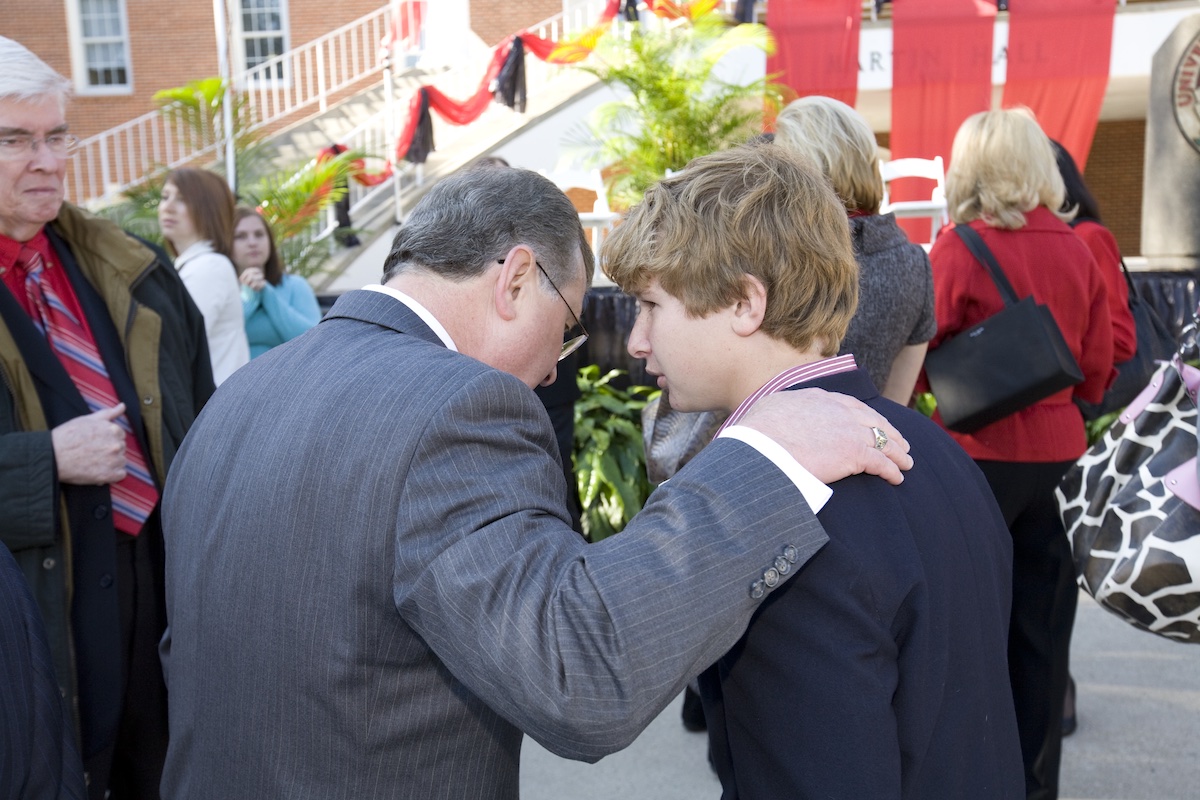
There was a more pragmatic consideration, as well. He had been commuting from Lafayette to Baton Rouge for about 12 years. The university presidency offered a chance to work closer to his home and family. “My 15-year-old son still likes to talk to me. I want to be around before that’s gone,” he said.
The UL System Board of Supervisors selected Savoie, although Landry was a strong contender. The tipping point seemed to be his state experience and exposure at the national level.
Andre Coudrain, a member of the UL System Board of Supervisors from Hammond, La., observed: “We’ve had strong local candidates in some searches and strong national candidates in others. For this one, we have the best of both worlds.”
Savoie’s first day on campus as president was July 2. A crowd of faculty, staff and students were waiting to welcome him warmly. One of his first moves was to appoint Dr. Steve Landry as provost, his second in command.
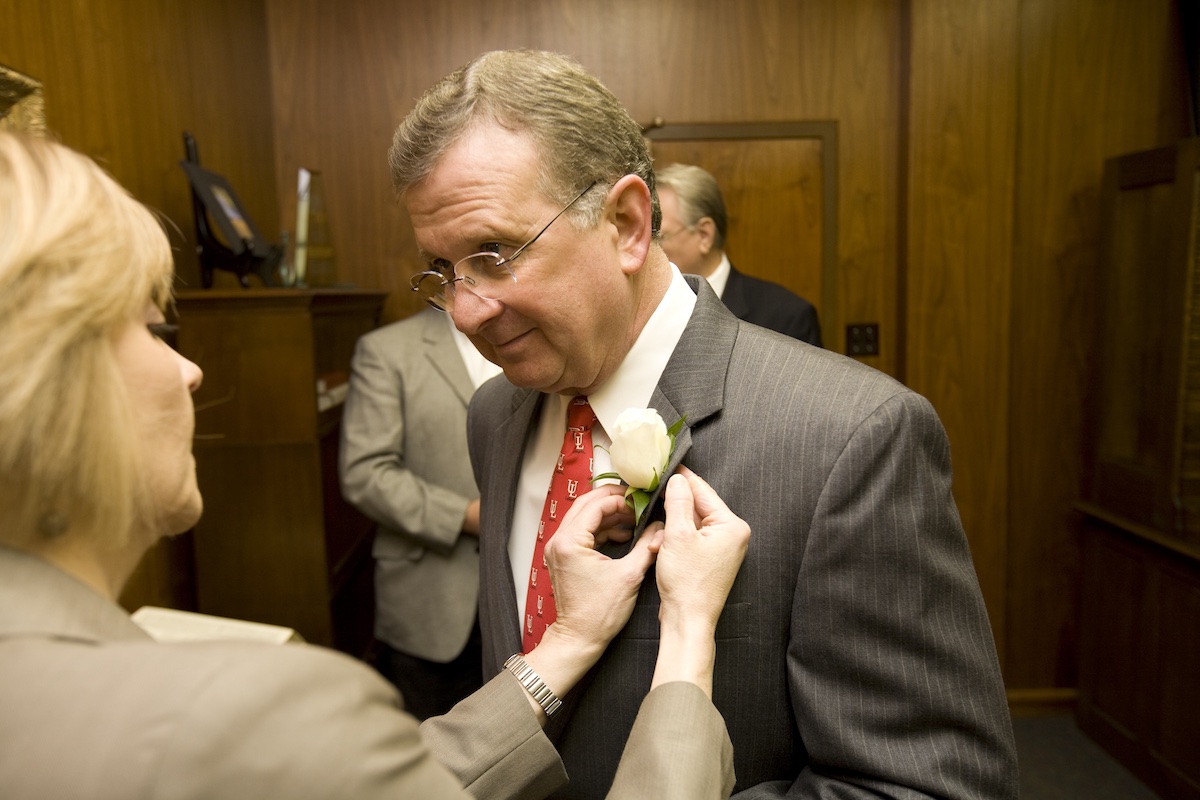
The new president wanted to wait until Homecoming week for inauguration events and his investiture ceremony. Some universities hold week-long inaugurations. Savoie’s was just one day and the ceremonies and activities were funded by private donations. Savoie’s address at his investiture ceremony gave the public a chance to learn more about him and his goals for UL Lafayette. Wearing his Ivy League doctoral robe from Columbia University, he walked over to the podium on a stage in the Cajundome and introduced himself to the audience:
“Ladies and gentlemen,” he began, “Joe the president.”
It was a funny line, delivered with his impeccable sense of timing. With only six words, Savoie managed to associate his status as a university president with Joe the Plumber, who had become sort of a contemporary symbol of middle-class America during debates between Barack Obama and John McCain.
The subtle, and probably unintentional, message: Savoie is every man and he is his own man.
It was the first inauguration in the University’s 110-year history. In his inaugural address, Savoie explained why it was held.
“Universities are one of the glories of human imagination and of human promise. For over a thousand years, universities have celebrated pride in their past and their hope for a better future. I thought this ceremony was important because this university deserves no less of an opportunity to express its pride and to celebrate its future than any other university in Louisiana or the United States. I want you to pay attention to things like this because they are the shape of things to come,” he said.
Savoie spent much of his address reviewing accomplishments of the five presidents who preceded him. He is a history buff and especially knowledgeable about UL Lafayette’s past.
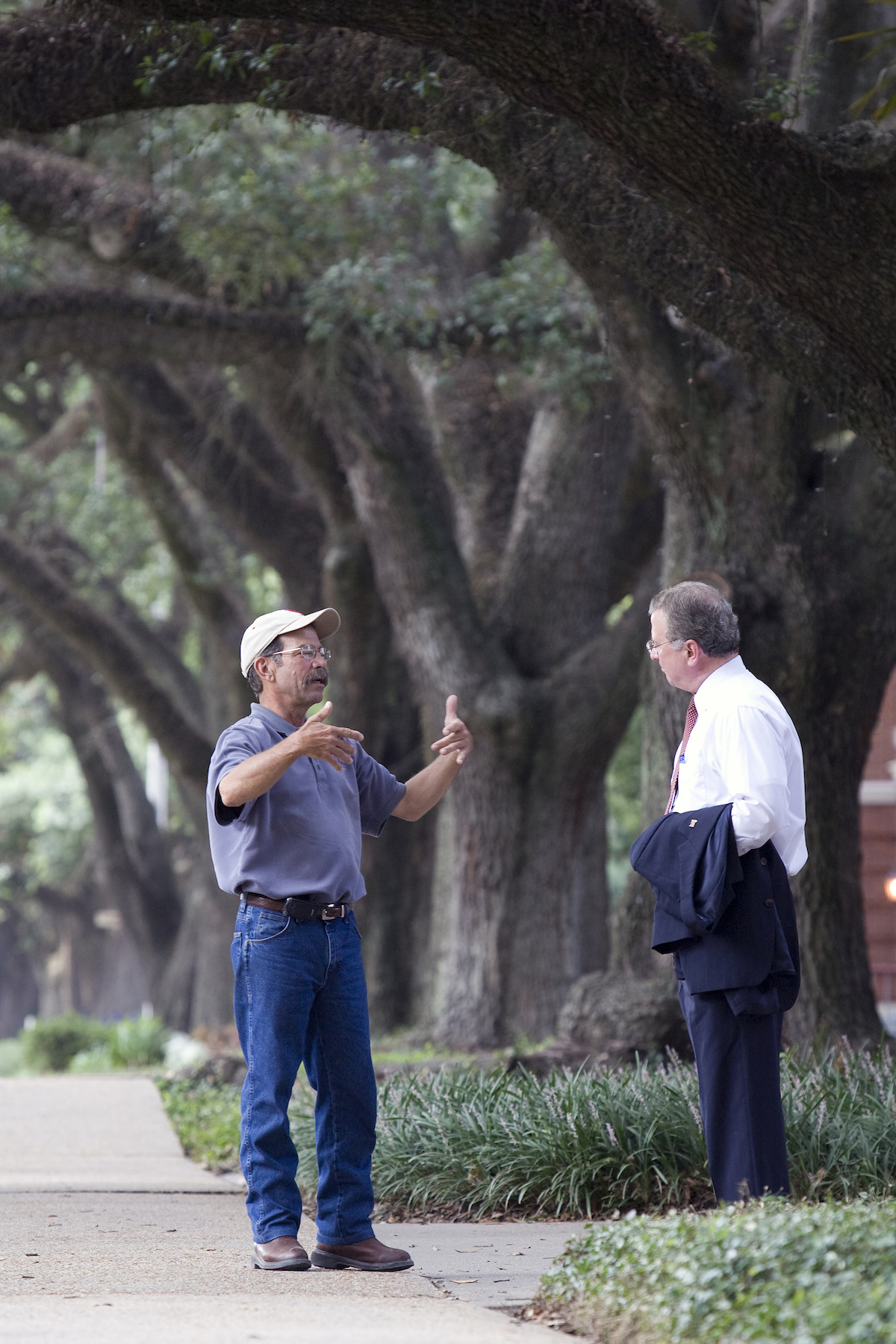
And, although the University’s strategic plan had not been completed yet, he cited a few “strategic imperatives” for the future:
“We will sharpen our focus on and improve student success. We will more strongly engage our students in a broad and meaningful university experience and facilitate not only technical competencies for job preparation, but the ethics and civic responsibility that are necessary for them to apply their skills in a responsible fashion.
“We will broaden our graduate school and our research capacity, both to inform intellectual curiosity and to foster economic growth and development. We will be good stewards of place by engaging our community partners to improve the economic, social, cultural and educational development of our community, our region, our state and our nation.
“We will secure our physical facilities and our strategic space by improving and modernizing our facilities and strategically acquire new space so that we and future generations can continue to build. We will create an institution that our stakeholders and our observers will highly regard.”
